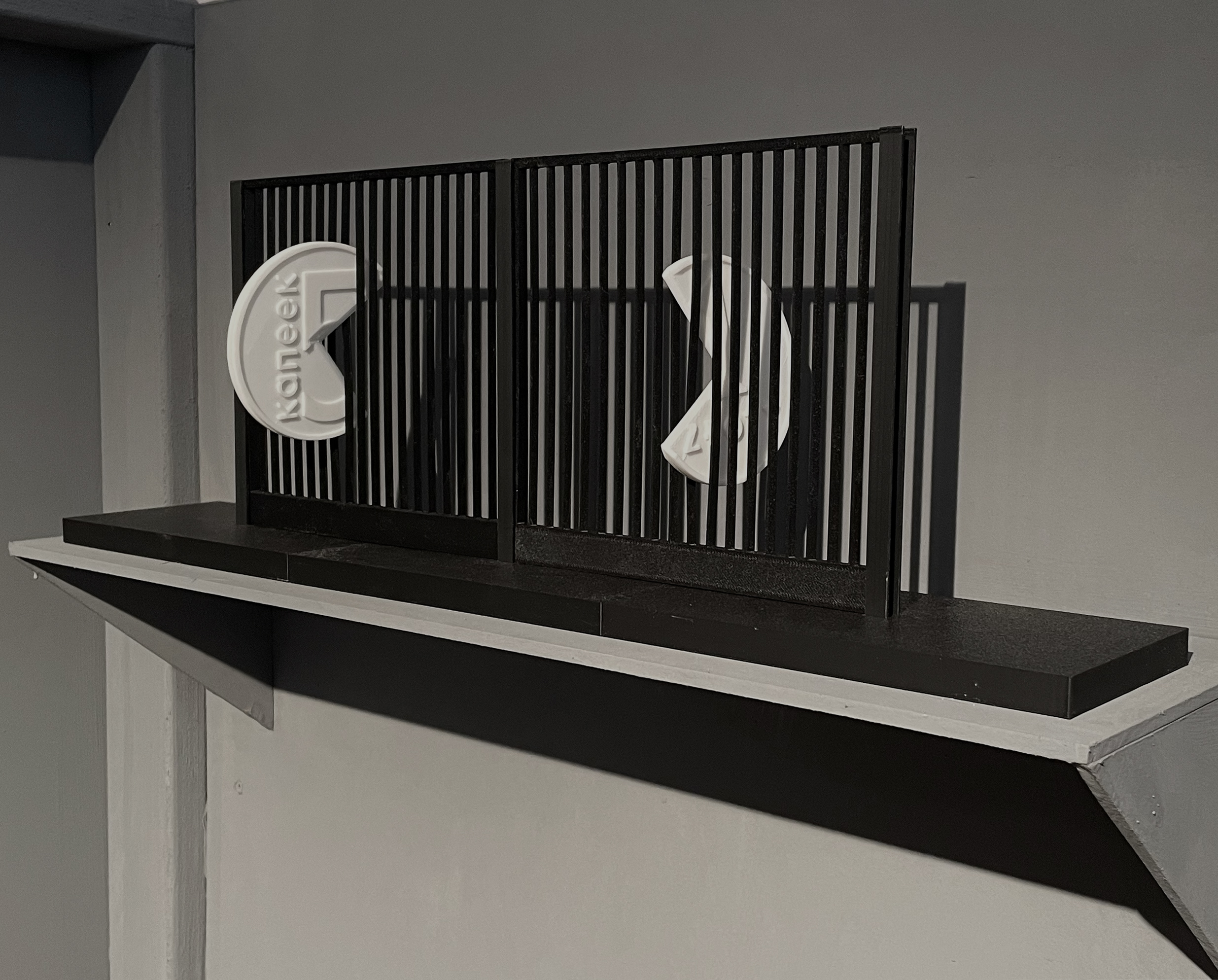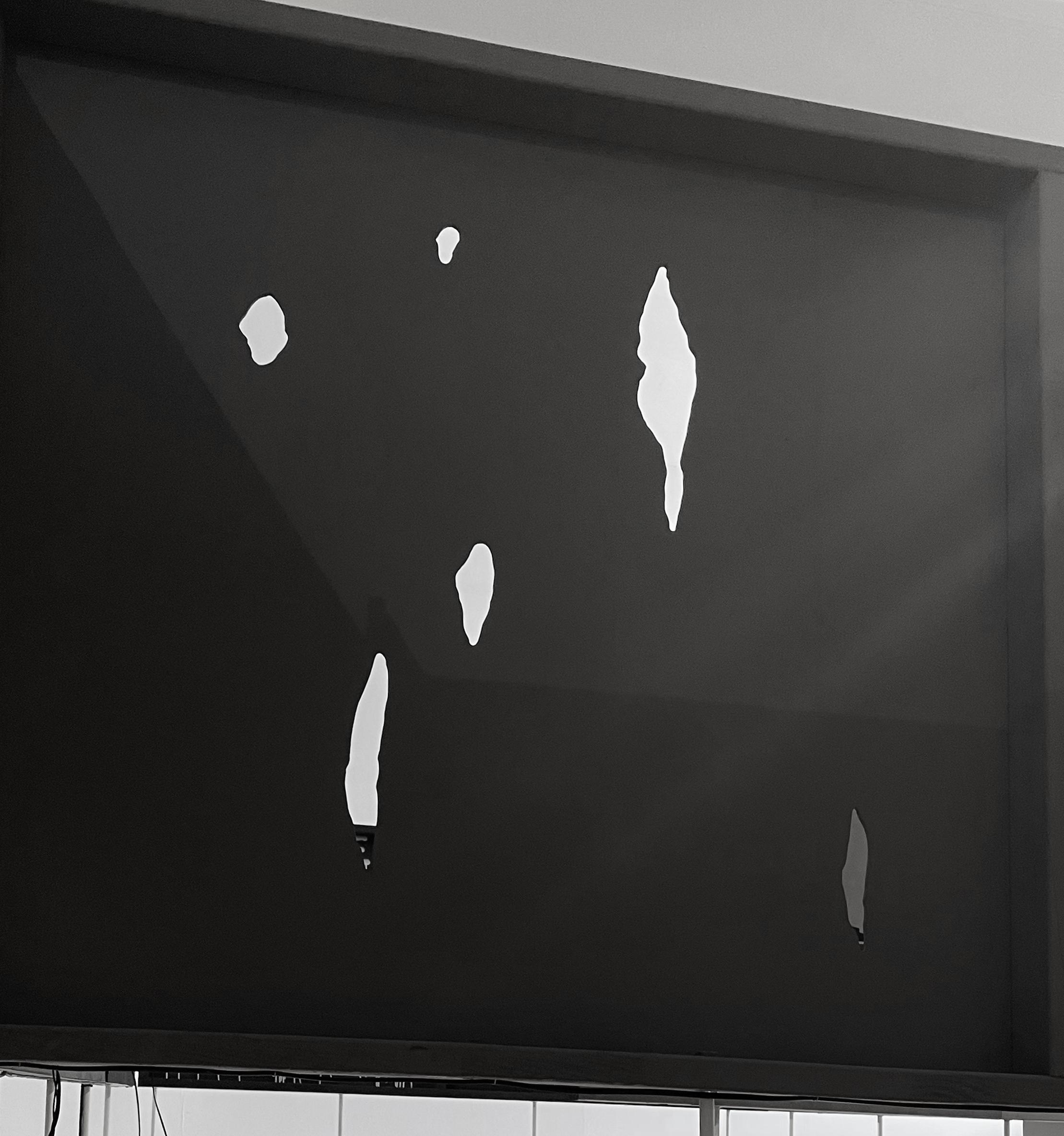ENG:
Plan:
Click on the desired section.
Section number:
# 3
Title:
The Border of Alienation
Tags:
Processes / slit:

Name of processes:
Breach // Breakthrough
Slit:
Wounds
Breach // Breakthrough
Slit:Wounds
Color:

Color number:
#444444
R, G, B:68, 68, 68
Section plan:

List of works:
A: Border-Gap slide show and video Violating the Boundaries of Biopower
B: sculptural object Thieves' Coins
C: photograph Canvas cut with the Karta Polaka
D: canvas Strategic Knee (In Memory of Railway Partisans)
E: canvas Fighting Memory: Polish Military Cemeteries
F: canvas New Barrier
G: torn holes on the wall
A: Border-Gap slide show and video Violating the Boundaries of Biopower
B: sculptural object Thieves' Coins
C: photograph Canvas cut with the Karta Polaka
D: canvas Strategic Knee (In Memory of Railway Partisans)
E: canvas Fighting Memory: Polish Military Cemeteries
F: canvas New Barrier
G: torn holes on the wall
A / 1:

Slideshow
Border-Gap
From the cycle Border-Gap
2018–2024
1’42”
The slideshow presents fragments from the *Border-Gap* cycle, focused on borders and ways of crossing/breaking through them: car doors with meat from the *Smuggling of Biomaterials* series, created in collaboration with Paweł Matyszewski; a series of canvases cut by the Pole’s Card; a seven-pointed star as a symbol of nomadism, and other works.
Border-Gap
From the cycle Border-Gap2018–2024
1’42”
The slideshow presents fragments from the *Border-Gap* cycle, focused on borders and ways of crossing/breaking through them: car doors with meat from the *Smuggling of Biomaterials* series, created in collaboration with Paweł Matyszewski; a series of canvases cut by the Pole’s Card; a seven-pointed star as a symbol of nomadism, and other works.
A / 2:

Video
2017
9’09”
The video documents the activities of border services on the Belarusian-Polish border in connection with the illegal transportation of meat, which here symbolizes the social body and the mechanisms of biopower.
Video, editing: Sergey Shabohin. Music: Gray Mandorla (Mikita Bubashkin and Sergey Shabohin)
Violating the Boundaries of Biopower
From the cycle Border-Gap2017
9’09”
The video documents the activities of border services on the Belarusian-Polish border in connection with the illegal transportation of meat, which here symbolizes the social body and the mechanisms of biopower.
Video, editing: Sergey Shabohin. Music: Gray Mandorla (Mikita Bubashkin and Sergey Shabohin)
B:

Sculptural object
2024
A model of three sections of the new fence built on the Poland-Belarus border is pierced with stolen coins. The cut coins, with sharpened edges, function as blades intended to slash the bags and pockets of potential victims. The cuts on the coins give them a Pac-Man-like appearance, referencing the labyrinth motif of the game and the entire installation, as well as symbolizing the bureaucracy, greed, and aggression of the authorities.
Idea: Sergey Shabohin. 3D modeling and printing: Roman Shabohin
Thieves' Coins
From the cycle Border-Gap2024
A model of three sections of the new fence built on the Poland-Belarus border is pierced with stolen coins. The cut coins, with sharpened edges, function as blades intended to slash the bags and pockets of potential victims. The cuts on the coins give them a Pac-Man-like appearance, referencing the labyrinth motif of the game and the entire installation, as well as symbolizing the bureaucracy, greed, and aggression of the authorities.
Idea: Sergey Shabohin. 3D modeling and printing: Roman Shabohin
С:

Photo
2018
A photograph documenting the gesture of cutting the canvas with the Polish Card, symbolizing bureaucratic migration processes and hopes for the future.
The exhibition presents a black and white version of the photograph.
Canvas cut with the Karta Polaka
From the cycle Border-Gap2018
A photograph documenting the gesture of cutting the canvas with the Polish Card, symbolizing bureaucratic migration processes and hopes for the future.
The exhibition presents a black and white version of the photograph.
D:

Canvas
2022
The canvas commemorates the railway partisans who, at the onset of Russia's full-scale invasion of Ukraine, disabled strategic railway junctions across Belarus to hinder the transport of Russian military equipment. The authorities brutally suppressed the partisans' actions, shooting the captured saboteurs in the knees.
Strategic Knee (In Memory of Railway Partisans)
From the cycle Border-Gap2022
The canvas commemorates the railway partisans who, at the onset of Russia's full-scale invasion of Ukraine, disabled strategic railway junctions across Belarus to hinder the transport of Russian military equipment. The authorities brutally suppressed the partisans' actions, shooting the captured saboteurs in the knees.
E:

Canvas
2022
On the canvas, painted in grisaille, is sand with bulldozer tracks at the site of destroyed Polish military cemeteries in Belarus. Over this, an inscription and image from a gravestone have been superimposed. In 2022, amidst the Belarus-Poland crisis, a mass anti-Polish campaign by the authorities began in Belarus, along with acts of vandalism against Polish memorial sites, aimed at appropriating and rewriting history.
Fighting Memory: Polish Military Cemeteries
From the cycle Border-Gap2022
On the canvas, painted in grisaille, is sand with bulldozer tracks at the site of destroyed Polish military cemeteries in Belarus. Over this, an inscription and image from a gravestone have been superimposed. In 2022, amidst the Belarus-Poland crisis, a mass anti-Polish campaign by the authorities began in Belarus, along with acts of vandalism against Polish memorial sites, aimed at appropriating and rewriting history.
F:

Canvas
2022
A fragment of the new fence on the Polish-Belarusian border has been painted on canvas using the grisaille technique, with the canvas repeatedly torn. The painting became part of a series on the migrant experience titled Canvas Cut by the Karta Polaka.
New Barrier
From the cycle Border-Gap2022
A fragment of the new fence on the Polish-Belarusian border has been painted on canvas using the grisaille technique, with the canvas repeatedly torn. The painting became part of a series on the migrant experience titled Canvas Cut by the Karta Polaka.
G:

Slit:
Torn holes on the wall.
Torn holes on the wall.
Photos:








